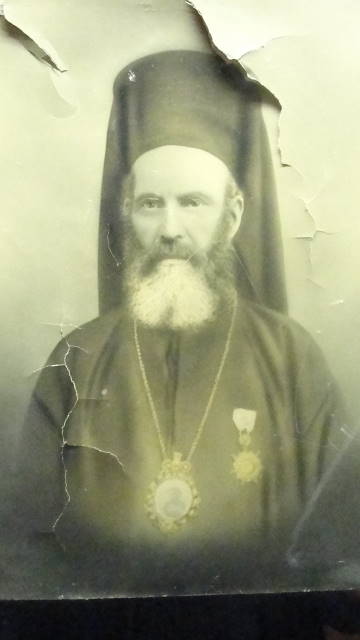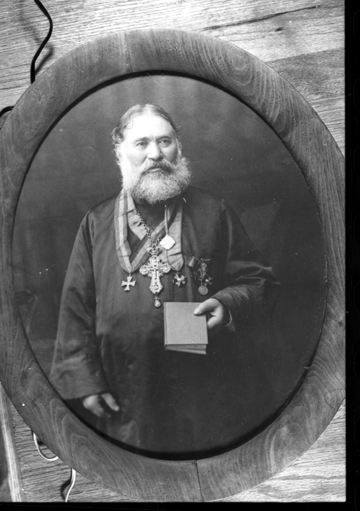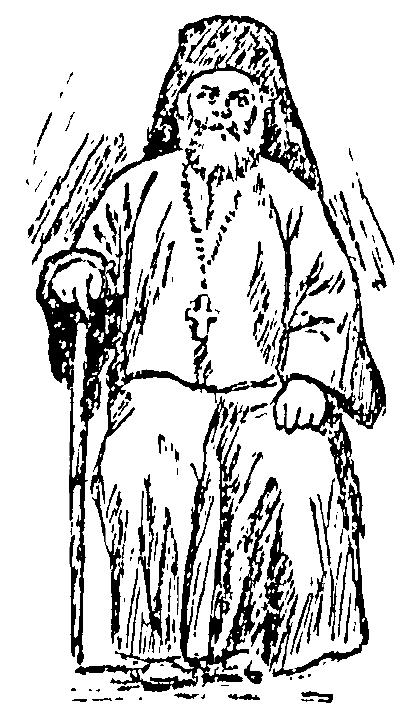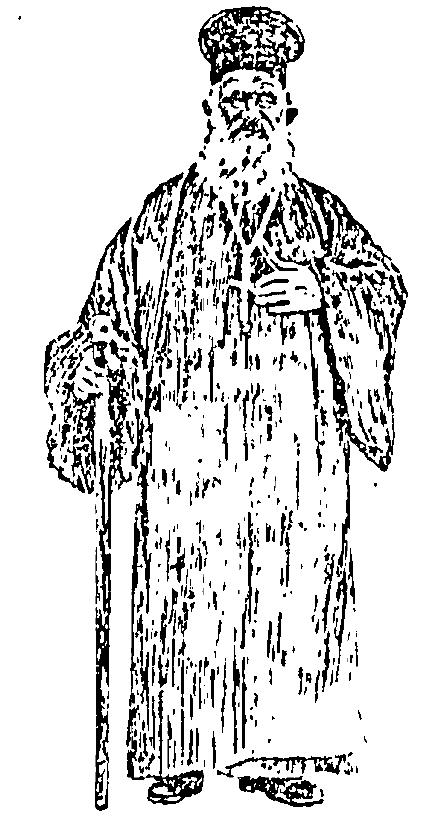I recently received an email from Fr. Timothy Sawchak, of Holy Trinity OCA Church in Kansas City. He sent the above photo, of a mystery clergyman. It was, apparently, discovered at an old studio and given to Annunciation Greek Church, also in Kansas City.
There was no writing on the photo, or markings of any kind, so beyond the image itself, we don’t have much to go on. Let’s see what we can determine from the photo.
First of all, this clergyman is probably Greek. Russian priests tended to be clean-shaven (or wear goatees) in the early 20th century, while their Greek counterparts were usually bearded until the mid-1920s. So, while it’s not definitive, I strongly suspect that this is a Greek clergyman, and that the photo was taken prior to 1930. (As a commentator noted below, this could also be a Serbian priest: the Serbian church in Kansas City predates the Greek one by a few years.)
While my initial impression was that this is a bishop, on closer study, I don’t think it is. I have photos and/or sketches of most of the early Greek bishops in America, and they obviously aren’t this man. He’s not Meletios Metaxakis, or Alexander Demoglou, or Philaret Ioannides, or any of the other bishops I’ve seen. And he’s definitely not one of the Russian bishops. Most likely, he’s an archimandrite.
On first glance, the mystery clergyman seems to be wearing a Panagia (icon of the Theotokos) around his neck, but look closer: doesn’t that look more like Christ, rather than his mother? That’s pretty rare: normally, a clergyman wearing an icon around his neck is a bishop, and usually, that icon is a Panagia. (The most notable exception I know of is St. Raphael, who wore an icon of his patron, the Archangel Raphael.)
Our mystery man is also wearing a medallion of some kind. I know that the Tsar often awarded medallions to clergy under the Russian jurisdiction, but I also know that the Greeks of Kansas City were not a part of the Russian Archdiocese. Does anyone out there know if the King of Greece, or some other civil or church authority, gave out medallions like this?
One of my first thoughts was that this might be Archimandrite Theoclitos Triantafilides, who was a Greek priest under the Russian Church. As we’ve seen in the past, Triantafilides was based in Galveston, Texas, but traveled widely. He’s not known to have visited Kansas City, but it’s possible that he passed through at some point. However, looking at the only known photo of Triantafilides, it doesn’t seem like a match:
I have very rough sketches of two of the other priests. Here is Annunciation’s first priest, Fr. Chariton Panagopoulos:
And here is Fr. James Rangos, who came to Kansas City around 1912:
Rangos is described by the Kansas City Star (4/30/1913) as being 60 years old. Obviously, he’s wearing a different sort of hat, and both he and Panagopoulos had crosses — not icons — around their necks. But, as these are only rough sketches, it’s hard to draw any conclusions.
Basically, I need your help. Can any of you identify the mystery clergyman in the photo at the top of the page? If so, please either leave a comment (below), or send me an email at mfnamee [at] gmail [dot] com. Thank you!




Is there any chance he could be Serbian? It looks like the first Orthodox Church in the Kansas City area was St. George Serbian Orthodox Church, and they list one “Archmindrate Joanikije Markovich” as their priest for several different periods.
Here’s the link:
http://www.st-george-church.org/English/Past_Clergy.htm
Yes, it’s certainly possible that the priest is Serbian. I can’t find any photos of the KC Serbian priests of the era, but it’s a distinct possibility.
So you got me curious. St. Sava Serbian Orthodox Church in Milwaukee lists one of it’s early priests as “Archimandrite Hadji Joanikije Markovich-Decanac,” also from around that period (http://www.stsava-milw.org/history.html). Still no photos though.
I’m not sure what “Hadji” signifies in Serbian usage, but if it’s any connection to the Arab usage (one that has made the Haj), that’s really odd.
The title “Hadji” (or “Hajj”) is indeed connected to the Arab Muslim usage. Among Arab Christians, the term was (is?) used to refer to someone who made a Christian pilgrimage, usually to Jerusalem. My great-great-grandfather was known as “Hajj.” There was a Greek priest in America in the early 20th century named Fr. Constantine Hadjidemetriou, which I assume refers to the fact that he (or perhaps his father or an ancestor) made a pilgrimage to the tomb of St. Demetrios, in Thessaloniki. (I could be wrong about that; it’s just my assumption.)
Incidentally, I called St. Sava Cathedral in Milwaukee to ask if they had a photo of Fr. Markovich, and they did not. The search continues…
Hadji is a reasonably common prefix to Greek surnames. Mostly, I think it has to do with pilgrimage to the Holy Land during the time of the Ottoman occupation.
One way of construing these surnames is that there may have been a man whose first name was Demetrios who went on a pilgrimage. His family could then be called Hadjidemetriou since this would be understood as “being of the family of the Demetrios who went on pilgrimage,” since Demetriou is the genetive of Demetrios.
Among names that I have come across in Greece are Hadjidemetriou, Hadjinikolaou, Hadjigeorgakis and Hadjipetrou. One can pick almost any common masculine Greek forename, put a hadji prefix and a Google search will come up with people with that surname.
There is also a very well known surname Hadjidakis which has the Cretan suffix akis so that this name might be translated as “of the family of the man who went on the hajj.”
I may be mistaken, but his pectoral icon does not appear to be of Christ. I see a man with his bare arms crossed on his chest, looking off to the left and downward. It is a familiar image, but I can’t recall who it is.
You could be right, Mark. My impression was that the light color in the middle of the image was the Gospel book. If it is an icon of Christ, he’s probably holding a Gospel book with one hand and blessing with the other.
Actually, I’m now thinking it is of Christ: the icon of “Extreme Humility”. Usually that icon has a Cross in the background. If this one does, it isn’t visible to my eyes.
Funny, I thought the light color in the middle looked like a lamb….
With the recent article published on Archbishop Dionysius I can’t help to notice a similarity between the sketch of him and this photograph.
Joseph, I’m pretty sure it’s not Abp Dionysius. The mystery photo was found in a studio in Kansas City, and there’s no evidence that Abp Dionysius ever passed through that city. Also, from other images I have of Abp Dionysius (which I will eventually post on the website), it’s pretty clear that he’s not our mystery man.